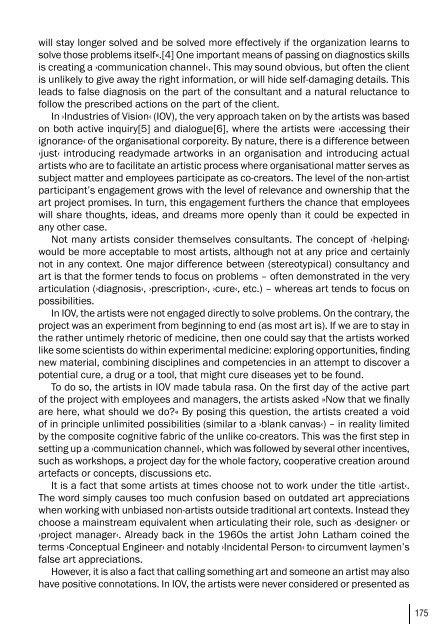art-e-conomy _ reader - marko stamenkovic
art-e-conomy _ reader - marko stamenkovic
art-e-conomy _ reader - marko stamenkovic
Create successful ePaper yourself
Turn your PDF publications into a flip-book with our unique Google optimized e-Paper software.
will stay longer solved and be solved more effectively if the organization learns to<br />
solve those problems itself«.[4] One important means of passing on diagnostics skills<br />
is creating a ›communication channel‹. This may sound obvious, but often the client<br />
is unlikely to give away the right information, or will hide self-damaging details. This<br />
leads to false diagnosis on the p<strong>art</strong> of the consultant and a natural reluctance to<br />
follow the prescribed actions on the p<strong>art</strong> of the client.<br />
In ›Industries of Vision‹ (IOV), the very approach taken on by the <strong>art</strong>ists was based<br />
on both active inquiry[5] and dialogue[6], where the <strong>art</strong>ists were ›accessing their<br />
ignorance‹ of the organisational corporeity. By nature, there is a difference between<br />
›just‹ introducing readymade <strong>art</strong>works in an organisation and introducing actual<br />
<strong>art</strong>ists who are to facilitate an <strong>art</strong>istic process where organisational matter serves as<br />
subject matter and employees p<strong>art</strong>icipate as co-creators. The level of the non-<strong>art</strong>ist<br />
p<strong>art</strong>icipant’s engagement grows with the level of relevance and ownership that the<br />
<strong>art</strong> project promises. In turn, this engagement furthers the chance that employees<br />
will share thoughts, ideas, and dreams more openly than it could be expected in<br />
any other case.<br />
Not many <strong>art</strong>ists consider themselves consultants. The concept of ›helping‹<br />
would be more acceptable to most <strong>art</strong>ists, although not at any price and certainly<br />
not in any context. One major difference between (stereotypical) consultancy and<br />
<strong>art</strong> is that the former tends to focus on problems – often demonstrated in the very<br />
<strong>art</strong>iculation (›diagnosis‹, ›prescription‹, ›cure‹, etc.) – whereas <strong>art</strong> tends to focus on<br />
possibilities.<br />
In IOV, the <strong>art</strong>ists were not engaged directly to solve problems. On the contrary, the<br />
project was an experiment from beginning to end (as most <strong>art</strong> is). If we are to stay in<br />
the rather untimely rhetoric of medicine, then one could say that the <strong>art</strong>ists worked<br />
like some scientists do within experimental medicine: exploring opportunities, finding<br />
new material, combining disciplines and competencies in an attempt to discover a<br />
potential cure, a drug or a tool, that might cure diseases yet to be found.<br />
To do so, the <strong>art</strong>ists in IOV made tabula rasa. On the first day of the active p<strong>art</strong><br />
of the project with employees and managers, the <strong>art</strong>ists asked »Now that we finally<br />
are here, what should we do?« By posing this question, the <strong>art</strong>ists created a void<br />
of in principle unlimited possibilities (similar to a ›blank canvas‹) – in reality limited<br />
by the composite cognitive fabric of the unlike co-creators. This was the first step in<br />
setting up a ›communication channel‹, which was followed by several other incentives,<br />
such as workshops, a project day for the whole factory, cooperative creation around<br />
<strong>art</strong>efacts or concepts, discussions etc.<br />
It is a fact that some <strong>art</strong>ists at times choose not to work under the title ›<strong>art</strong>ist‹.<br />
The word simply causes too much confusion based on outdated <strong>art</strong> appreciations<br />
when working with unbiased non-<strong>art</strong>ists outside traditional <strong>art</strong> contexts. Instead they<br />
choose a mainstream equivalent when <strong>art</strong>iculating their role, such as ›designer‹ or<br />
›project manager‹. Already back in the 1960s the <strong>art</strong>ist John Latham coined the<br />
terms ›Conceptual Engineer‹ and notably ›Incidental Person‹ to circumvent laymen’s<br />
false <strong>art</strong> appreciations.<br />
However, it is also a fact that calling something <strong>art</strong> and someone an <strong>art</strong>ist may also<br />
have positive connotations. In IOV, the <strong>art</strong>ists were never considered or presented as<br />
175


